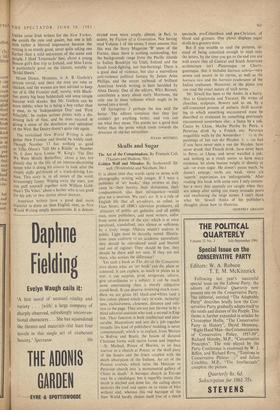Skulls and Sugar
I r is about time that words came to terms with photographs, writing with images. If 1 were a publisher of 'art books,' then reviews as they came in—their brevity, their skimpiness, their condescension, also their infrequency—would give me a neurosis. We can't see. It is a rule of English life that all art-editors, so called, in Fleet Street. all (BBC) television producers, all directors of public art galleries, and all public men, most publishers, and most writers, suffer from some disease of the eye; which is at once paralysed, scandalised, into silence or sulkiness, by a lively image. Objects mustn't undress in public. Light must he decently muted. Illustra- tions must conform to an academic naturalism; they should be reproduced small and blurred and out of register. They should be few, they should be there and not seen. If they are not there, who notices the difference?
Yet such a book as The Art of the Conquista- dors shows what an 'art book' can do, plain or coloured. It can explain, as much in plates as in text; it can surprise, prod, invigorate, inform, give co-ordinates to a subject; it can be much more entertaining than a merely subjective travel-book. It can deserve reviewing much more. Here we are given 181 black-and-whites (and a few colour plates) which vary in scale, inclusive- ness, exclusiveness, closeness, distance and rela- tion to the page. They are not just thrown in by a
blind editorial assistant who took a second in Eng- lish. Their function is both intellectual and plea.
surable. Illustrations and text do a job together (usually this kind of publishers' wedding is never consummated), which is to explain, from Mexico to Bolivia and Brazil, the fusion of dictated Christian forms with native forms and impuls, —SL Michael, Prince of Heaven, as an Inca warrior in a church at Potosi; or the skull piety of the Jesuits and the friars coupled with the death absorption of the Indians. An art of the Passion evolves, which turns the Mexican or Peruvian church into 'a monumental gallery of Christ in death.' A baroque church in Europe may be a catafalque. but it superbly insists that death is ditched and done for, the ceiling above destroys the roof and opens on to vistas of bliss without end, whereas this red baroque of the New World hardly shakes itself free of a death spectacle, pre-Columbian and pre-Christian, of blood and grimace. One photo displays sugar skulls in a grocery store.
But if you trouble to read the pictures, in- stead of being conceited enough to read only the letters, by the time you get to the end you are well aware that all Central and South American architecture isn't Plateresque or Churri- gueresque, that it includes barroco sobrio—very severe and ascetic in its curves, as well as the barroco rico and the barroco exuberance of the Indian craftsmen. Moreover, in the plates you can read the exact nature of such terms.
Mr. Sitwell has been to the Andes, in a hurry. Also to Guatemala and Yucatan. He writes of churches, sculpture, flowers and so on, by a self-contained process of aesthetic thrill accord- ing to which something encountered must be described or evaluated by something previously encountered somewhere else: a llama by a yak, Cuzco by Lhasa. Machu Picchu by Petra, a Peruvian drink by a French one. Peruvian megalithic walls by the Amsterdam I. ks in the paintings of Jan van der Heyden. I; is too bad if you have never seen a van der Heyden, have never drunk that French drink, have never been to Petra. or Lhasa. and never watched a yak; and nothing as a result seems to have muca existence, let alone human weight or density or salt—or even sugar. He doesn't pause much, he doesn't enlarge; verbs are weak, views are 'superb.' experiences are 'unforgettable.' After reading this book with some care I only remem- ber a story that quetzals are caught when they are asleep after eating too many avocado pears and swallowing the large stones. I can't think what Mr. Sitwell thinks of his publisher's thoughts about how to illustrate.
GEOFFREY GRIGSON


































 Previous page
Previous page